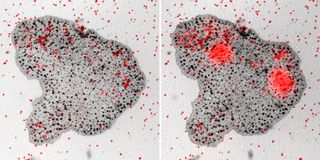No Organs, No Problem: Weird Animal Hunts Without Nerves or Muscles

It's amazing what can be accomplished without a brain. Ask Trichoplax. This tiny multicellular animal — only a millimeter across — has nothing recognizable as muscle or nerve cells. In fact it has no organs at all. And yet it can hunt down, dissolve and consume algae with surprising sophistication, new research shows.
Trichoplax "behaves as if it has a nervous system, yet lacks typical nerves and synapses," the connections between brain cells over which information travels, said study senior author Thomas Reese, a senior investigator at the National Institute of Neurological Disorders and Stroke in Bethesda, Maryland. "In this respect, our work appears to offer a first look at how nervous systems may have evolved."
Trichoplax adhaerans (or Trix, as the researchers call it) is found worldwide, crawling capably across shallow seafloors on a belly covered in hairlike cilia, and feeding on algae. It is the sole member of the phylum Placozoa and therefore represents a huge and mostly enigmatic branch of the tree of life. (By comparison, all vertebrates from mice to minnows to humans fit into just one subgroup of the phylum Chordata.) [Cambrian Creatures: See Photos of Primitive Sea Life]
Strange organism
Study lead author Carolyn Smith, a senior investigator at the National Institute of Mental Health, first encountered Trix by chance in 2008, she told Live Science. The researcher was studying sponges to learn about the early stages of nervous system evolution "when I saw this cool little creature come pirouetting across my microscope screen."
A few weeks later, Smith recognized her pirouetting creature in a scientific paper on the genome of Trichoplax. She was fascinated by the presence of nervous system genes in this primitive, disk-shaped metazoan, she said. "This guy was much more interesting than a sponge," said Smith, who has been married to Reese for 30 years.
In a 2014 study, Smith, Reese and their colleagues used light and electron microscopy to describe two previously unknown cell types in Trix, bringing its grand total of body cell types up to six. (Humans, by contrast, have hundreds of different cell types.) One of the new types, called crystal cells, may let Trix sense its environment; the other, called lipophil cells, are spaced out across the animal's belly and contain granules of some type of chemical that the researchers hypothesized might be digestive enzymes.
Sign up for the Live Science daily newsletter now
Get the world’s most fascinating discoveries delivered straight to your inbox.
How Trix eats
In the new study, Smith and colleagues used high-speed microscopy to capture Trix's feeding behavior in real-time and electron microscopy to examine the creature's anatomy at a fine scale. Electron microscopes have much a higher resolution than optical microscopes because they use electron beams, which have wavelengths around 100,000 times smaller than that of light.
The researchers found that when Trix discovers a patch of algae, cilia across the animal cease beating and lipophil cells near the algae release digestive enzymes that rip the algal cells open, spilling their cellular guts. Trix presses down on top of the opened-up algae to create a sealed compartment, and cells in Trix's belly churn as if sucking up the contents of this exploded meal. These results suggest Trix must have some way of coordinating its hundreds of cells to detect a potential meal, stop moving, and trigger targeted external digestion and feeding behavior. [Explosive Meal: Watch Trix Feeding on Algal Cells — Video]
The new study is "a wonderful piece of work," said Leo Buss, a professor of ecology and evolutionary biology at Yale University, who was not involved in the study. "These are among the simplest creatures there are," Buss told Live Science, and yet the new discovery "implies they can keep track of space and have some measure of short- and long-range cellular communication.
"We have a spotty understanding of how digestion and nervous systems evolved in lower organisms," Buss said. "There's a great scientific opportunity here."
In fact, Smith told Live Science, Trix behaves very much like a tiny independent patch of the human gut, which also senses food particles, manipulates them with cilial cells, secretes digestive enzymes and absorbs the nutrients that are released.
So, by researching this independent patch of gut, scientists may learn more about the early evolution of the nervous system, the researchers said. Perhaps, Reese said, "The way to understanding man's brain is truly through his stomach."
Smith and her colleagues reported their findings online today (Sept. 2) in the open-access journal PLOS ONE.
Follow us @livescience, Facebook & Google+. Original article on LiveScience.
